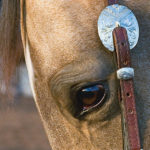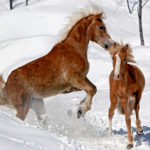
For most of us, trail riding is all about relaxation and enjoyment. When you leave behind the rigors and repetition of arena work, you can simply savor the experience of being in the saddle and perhaps getting to know your horse a bit better.
But sometimes a trail outing becomes a test of wills–and your skills. It’s hard to relax on a ride punctuated by successive spooks or interrupted by refusals to cross water or pass “scary” objects. And it’s exhausting trying to control constant jigging or, conversely, squeeze a little momentum out of a sluggish mount. The disappointment is even greater if every other horse on the ride seems to be taking everything in stride. What is it about those horses that makes them so much more fun to ride on the trails?
Finding the answer means looking beyond specific incidents and frustrations and taking a broader view of your horse’s training. To perform well on the trail, a horse must have a good foundation, says trainer and clinician Jonathan Field from British Columbia, Canada. “People don’t equate the same level of prep for trail riding as other disciplines because it seems like such a simple endeavor,” he says. “But the people who are living the dream, they’re the ones who have put in the time to make that horse the best trail horse he can be.”
To set out on that path yourself, you may need to revisit a few basic training exercises. Many of these will involve skills your horse learned long ago but hasn’t had to use very often. Others will focus on gaps in training that can be fudged a bit in the security of the riding ring but become significant issues when you’re away from home. But, mainly, going back to the fundamentals will help you address larger issues of compliance and respect that underlie many trail behavior problems.
Here are the seven things to teach your horse to keep your trail outings as harmonious and enjoyable as possible.
1. Teach your horse to: Load willingly.
“Big red flags go up when I see someone having trouble loading because it tells me about the willingness of the horse and if he has respect for the rider,” says Gary Woods, a frequent trail rider from Gilbert, Arizona, who is also my riding instructor of many years.
Loading into a trailer is basic to trail riding; you won’t get to many far-flung trails without a willing traveler. Although horses tend to be a little claustrophobic by nature, most learn to tolerate hauling, given enough time and patience. But loading problems are usually not just about getting into a trailer. They’re almost always about you and your horse, and where you stand in his estimation of your leadership skills.
I learned this the hard way years ago, when I called Woods to ask if he could help me retrieve my horse, Louie, from a friend’s backyard after he refused to load for two days. Woods said he could help, but that it would take patience, trust and groundwork. He was right. Today, Louie is a consistent loader. He hops into any trailer when asked, and just as important, once we arrive at the trailhead, he’s quiet, confident and a pleasure to ride.
“If the horse is stressed out the whole time he’s in the trailer, and he’s burned up every ounce of confidence he’s ever had, and he’s sweating and scared, how is he ever going to go on that great ride you want?” points out Field. If you take the time to teach your horse to haul safely and confidently, many other issues will resolve themselves in the process, he says. Along with gaining the horse’s trust, exercises such as sending him over tarps and driving him through narrow openings can help prepare him for loading and hauling, according to both Woods and Field.
2. Teach your horse to: Go where you point him.
A good trail horse will go willingly over obstacles, around rocks, down canyons and, especially, through water. “At some point you’re going to come to water that you have to cross, and if your horse refuses, you’re going to have a problem,” says Field.
Some horses are willing to cross water and go where you point them, either by training or by nature. Woods says he can tell a lot about a horse’s willingness by his response to pressure. “If I touch his rib cage, I expect the horse to move over. If he doesn’t, that doesn’t mean I can’t teach him to move off of pressure, but a good trail horse will already have that ability,” he says.
An unwilling horse is one of the more common problems for trail riders, but it’s also one of the more fixable ones, given the right training and leadership. Both Woods and Field do leading exercises to get the horse in sync with his handler’s body language. “If I’m not able to control the path on which my horse walks from the barn to the stall, why is he going to pay attention when we get out there and things get a whole lot more interesting?” points out Field, who expects his horses to walk stride for stride with him, just as they would with the herd.
“By having that level of sensitivity to the herd and awareness to every movement, they have no time to focus on anything else. Their focus is locked in on me, the leader,” he explains.
3. Teach your horse to: Come back to neutral.
A good trail horse will keep a cool head no matter what is happening around him. A mare in season, a barking dog or a small-scale mutiny among the other horses on a ride—any of these situations can turn ugly if your horse overreacts. “I see this happen a lot. A horse in the group becomes animated and starts bossing other horses around, and someone’s horse explodes as a result,” says Field. Some?horses naturally have a calm and willing disposition, yes, but training, leadership and riding with intention can help to defuse any horse and bring him back to neutral in eventful situations.
“So many recreational riders are just going along. They’re not active in their intention, and the horse feels he has to look out for himself as a result,” says Field. Keeping your horse’s mind engaged while in hand or under saddle, and generally riding with purpose can help cooler heads prevail in times of high stress and uncertainty.
4. Teach your horse to: Be careful about where he puts his feet.
He has four of them, and he should know where they are and where you want him to put them next, says Woods. This is especially important when your horse is asked to scramble down a steep canyon of loose rock or to scoot around, say, a moving bike or low-hanging branch. I had some time to think about this recently as a small group of us braved a too-narrow mountain pass with a steep drop-off on one side. I remembered my conversation with Woods years ago, at a frustrating time when just about everything needed to be trained in or out of my little brown horse. “Give me one good reason why I should keep him,” I said to Woods, who replied, “Because he is sure-footed.” He was right, of course. Over the years, I’ve spent more than a few anxious moments in the saddle thanking my lucky stars that my horse could keep all fours on the ground during incredible circumstances and on tough terrain.
But what if your otherwise trail-worthy horse trips from time to time and sometimes seems a bit unstable? Woods and Field suggest getting him to pay attention to his feet by asking him to step over cross rails, around poles and through obstacles of all kinds, and the more uneven the ground, the better. “I’m never quite comfortable with a horse who’s raised on the flat because it’s like riding two horses. He’s bound to be out of balance so that if he gets in trouble on the front end, his back end can’t help him. Horses like this get trippy,” observes Field. He likes to back his horses up hills and down hills, and to get them to lift up their feet and round their backs when possible. “I want to see them get worked up and down hills in hand to figure out how to get themselves balanced, so that by the time I get on them, they have a pretty good idea where to put their feet,” he adds.
5.Teach your horse to: Overcome his flight instinct.
One day you’ll be ambling along the trail and, in the blink of an eye, you’ll come across a bear or deer or, more likely, a bush with fangs. Your horse’s split-second reaction should be to stop, not bolt, and to wait for your cue. “If I can wriggle the rein, and his ear comes around as if to say, ‘Yes, I’m here,’ that’s good. But if I try to wriggle my rein or touch him with my leg and he doesn’t move, that’s not good,” says Field, explaining that a refusal to move is almost as bad as a bolt—and, in fact, is a precursor to a bolt. “Anybody who has started young horses knows that the longer the horse takes to take his first step, the more he is going to come apart when he does because he’s stored up energy,” he explains.
Of course you can’t expect that your trail horse will never spook, but you’ll want to teach him not to overreact when he does. “He is going to spook at some time, so the question is how big is his reaction and how long is it going to be before he’s OK with it?” says Field. Simple observation can tell you a lot about how a horse reacts to new stimuli. Is he explosive without warning? Or does he take things in stride? Does he get worked up slowly and remain in a heightened state of alert for a long period? Or does he snort, approach the object of concern and return to a more relaxed state within no time?
Easygoing horses who quickly recover from surprises make the best mounts for trail riding. But it’s wise to spend time building any horse’s confidence. Trail challenge competitions and play days are great for desensitizing the horse and exposing him to new stimuli in a controlled setting. In addition, Woods suggests establishing a relaxation cue, such as a pat on your horse’s withers or a slight lift of one rein as a “Come back to me” or “It’s OK” cue as one more measure of control should your horse’s world turn upside down while ambling down the trail.
6.Teach your horse to: Maintain his independence from other horses.
If your horse is friendly with his herdmates, that’s fine. But if he’s glued to the tail of the horse in front of him, that’s not. Likewise, if one horse in the group trots, your horse shouldn’t have to trot, too.
Seemingly little issues like these can become dangerous quickly if you’re separated from the group for any reason or if one horse bolts or starts acting out and your horse follows suit. “So often these horses live in small spaces, and they’re not used to horses coming and going. If their riders don’t fundamentally have the leadership to keep these horses with them, they lose control,” says Field.
To find out where your horse falls on the herd-bound spectrum, both trainers suggest watching him interact with his herd or taking him out for a ride alone. Does he call out to other horses or balk when leaving the property alone? Does he feed off the energy of other horses in the pasture? Does he readily back down when challenged by the herd? Or is he overly bossy?
An insecure horse is more likely to be herd-bound than a more confident one, but aggressive horses also exhibit a related behavior—a tendency to be bossy or pushy toward other horses, according to Woods.
He suggests exercises such as gradually lengthening the distance between you and other riders and keeping the horse’s attention on you at all times, which is at the heart of all herd-bound issues. “The reason he’s looking to other horses is because he doesn’t trust you, and that’s the number-one thing you need to develop in a good trail horse,” says Woods.
7. Teach your horse to: Head out as eagerly as he heads home.
A good trail horse has to be able to go anywhere without issue. He won’t jig, grow anxious, or bolt for the barn at the first sign you’re turning for home.
Barn-sour horses typically lack confidence and have many of the same tendencies as the herd-bound horse, and they may even be attached to their herdmates as well as to familiar surroundings.
Horses who are more curious by nature or have been exposed to different environments early on are more likely to adjust to the novelty of trail riding, while habitually barn-sour horses are more predisposed to be anxious in new settings and situations, according to Field. He says that many horses fall somewhere between these two extremes and simply need more exposure to new and different surroundings before they make confident mounts.
“A lot of horses live in 10- by 10-foot pens, and suddenly they’re put out on the side of a mountain somewhere with little or no preparation whatsoever. You have to be willing to prepare them for trail riding like you would any other activity,” says Field, who advises ponying a young horse with a more experienced, confident horse when possible.
He also suggests slowly expanding the barn-sour horse’s zone of comfort around a familiar trailhead or arena to help him gain confidence and adjust to new environments.
There’s one last thing you’ll want your trail horse to have, but it’s not something you teach with lessons or exercises: It’s a good attitude. A good attitude trumps all other desirable characteristics in a trail horse simply because with the right attitude, he is more inclined to load willingly, get along with other horses, and keep his cool during times of excitement and uncertainty.
A good attitude means he’s confident in his abilities as a trail horse and he’s enjoying the ride to the extent that any horse can.
No doubt, your horse has already let you know his feelings on the matter. If he’s difficult to catch, balks or pins his ears at the merest suggestion that you’ll be saddling up for a trail ride, he could be telling you he doesn’t like his job and it might be time to reconsider his trail prospects. But if he nickers to you when you hook up the trailer, greets you at the gate, and practically puts on his halter himself when you go to catch him, you can be fairly certain he likes to trail ride.
A trail horse with this kind of attitude is worth his weight in gold.
This article first appeared in EQUUS issue #425.






